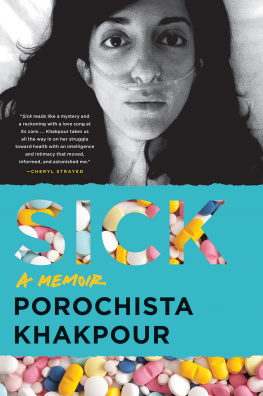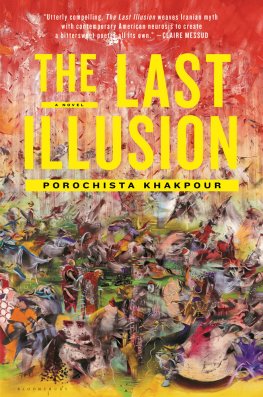Contents
This book contains my personal story. I am not a medical professional, and, therefore, the inadvertent advice and information I share throughout this book is in no way intended to be construed as medical advice. If you know or suspect that you have a health problem, it is recommended that you seek the advice of your physician or other professional advisor before embarking on any medical program or treatment.
To Voyce
& her honeybees
Those great wars which the body wages with the mind a slave to it, in the solitude of the bedroom against the assault of fever or the oncome of melancholia, are neglected. Nor is the reason far to seek. To look these things squarely in the face would need the courage of a lion tamer; a robust philosophy; a reason rooted in the bowels of the earth.
Virginia Woolf, On Being Ill
Do you believe, she went on, that the past dies?
Yes, said Margaret. Yes, if the present cuts its throat.
Leonora Carrington, The Seventh Horse and Other Tales
It seems impossible to tell this story without getting the few certainties out of the way, the closest one can come to facts. The hardest part of living with Lyme disease for me has always been the lack of concrete knowns and how much they tend to morph and blur over the years, with the medical community and public perception and even within my own body. To pinpoint this disease, to define it, in and of itself is something of a labor already.
Still: Lyme disease is a clinical diagnosis, a disease that is transmitted by a tick bite. The disease is caused by a spiral-shaped bacteria (spirochete) called Borrelia burgdorferi. The Lyme spirochete can cause infection of multiple organs and produce a wide range of symptoms. Less than half of Lyme patients recall seeing a tick bite, and less than half also report seeing any rash. (They say the deer tickwhich is usually the carrier of Lymecan present as smaller than a speck of pepper.) The erythema migrans (EM) or bulls-eye rash is considered the main sign of Lyme, but atypical forms of this rash are seen more frequently. Testing is quite flawed; the commonly used ELISA (enzyme-linked immunosorbent assay) screening test is unreliable, missing 35 percent of culture-proven Lyme disease. There are five subspecies of B. burgdorferi, over one hundred strains in the USA, and three hundred strains worldwide. Testing for babesia, anaplasma, ehrlichia, and bartonella (other tick-transmitted organisms) should always be performed as well, as coinfection with these organisms points to probable infection with Lyme and vice versa.
There are multiple stages and progressions of the disease. Stage 1 is called early localized Lyme disease, and it signifies a stage where the bacteria have not yet spread throughout the body; this form of Lyme can be cured with timely antibiotic use. Stage 2 is called early disseminated Lyme disease, and here the bacteria have begun to spread throughout the body. Stages 3 and 4 are often known as chronic and late-stage Lyme disease, and at this point the bacteria have spread throughout the body. Many patients with chronic Lyme disease require prolonged treatment, all while relapses may occur and retreatment may be required. There are no tests to prove that the organism is at any point eradicated or that the patient with chronic Lyme disease is cured, although one can test for inflammation and other markers. Each year, approximately thirty thousand cases of Lyme disease are reported to the CDC. Over the past sixty years, the number of new cases per decade has almost quadrupled; the number of outbreaks each year has more than tripled since 1980.
I have Lyme, with bands (lines on a test that represent antibodies to different components of the bacteria) that afford it CDC-level recognition (bands 23 and 41). My main coinfection has been ehrlichia. Several doctors believe I also have babesia and bartonella due to certain symptoms, although my tests dont always come out positive for them.
Living with this disease has cost me more than $140,000 so far. Experts put the average cost of late-stage Lyme at somewhere around $20,000 to $200,000. The annual cost of Lyme disease in the United States is more than $1$3 billion as of 2017.
It is unclear when I got the disease. Doctors have mostly pinpointed somewhere in the 2006 to 2009 range, but Ive had doctors who think Ive had it since childhood. Although the disease and its complicationsincluding addictionshave defined my life, it is unlikely I will ever know when I contracted it, just as it is unlikely I will ever be rid of it entirely.
I have never been comfortable in my own body. Rather, Ive felt my whole life that I was born in the wrong body. A slight woman, femme in appearance, olive skin that has varied from dark to light, thick black curly hair, large eyes, hands and feet too big, of somewhat more than average height and somewhat less than average weightIve tried my whole life to understand what it is that seems off to me. Its deeper than gender and sexuality, more complicated than just surface appearances. Sometimes the dysmorphia I experience in my body feels purely psychological and other times it feels like something weirder. As a child, I thought of myself as a ghost, an essence at best whod entered some incorrect form. As I grew older, I accepted it as otherness, a feature of Americanness even. But every room I walk into I still quickly assign myself to outsider status, though it seems not everyone can see this. Many have in fact called my looks conventional, normal, even good. Ive accepted it while also feeling like Ive deceived them.
Ive looked for answers from my first few years on this earth, early PTSD upon PTSD, marked by revolution and then war and then refugee years, a person without a home. Could that have caused it? Was displacement of the body literally causing a feeling of displacement in the body?
Only decades later did I confront something that may have been there the whole time: illness, or some failure of the physical body due to something outside of me, that I did not create, that my parents did not create. Illness taught me that something was wrong, more wrong than being born or living in the wrong place. My body never felt at ease; it was perhaps battling something before I knew it was. It was trying to get me out of something I could not imagine.
At some point, with chronic illness and disability, I grew to feel at home. My body was wrong, and through data, we could prove that.
Because my illness at this stage has no cure, I can forever own this discomfort of the body. I can always say this was all a mistake. To find a home in my body is to tell a story that doesnt exist. I am a foreigner, but in ways that go much deeper than I thought, under the epidermis and into the blood cells. I have started to consider that I will never be at home, perhaps not even in death.
Its New Years Eve, about to turn 2016, and Ive been where I always am: inside. A neighbor visits and drops off some leftover Christmas chocolate I cant eat but gladly accept; a friend a few blocks away comes by with his toddler son and invites me to his home for a small party that we both know I cant attend; friends all over the city send email and text invites to events just in case. Ive never not been a party girl. This was my fathers greatest fear for me in the United States, but one that I balanced with what would become his greatest dream for me: being an author. A cross between Salman Rushdie and Paris Hilton, he used to joke.
But I know that this New Years there will be no parties for me. This New Years will be my first spent alone.
Twenty days before, I was in a car accident. Hit by a semian eighteen-wheeler tractor-trailer, to be preciseon the way home from my job, teaching at Bard College. Class was out by 1:10, but I stayed late that Friday, rare for me. It had been a season of hate crimes, a month and a half after the Paris attacks, and tensions were especially sky-high for brown and black students. I was the only faculty of color in our department that term and the students seemed to look to me for answers. I hid that I was as lost as them. I had packed extra snacks and all sorts of reinforcements, as Id call the supplements that Id been taking for years for Lyme disease relapsesfrom Celtic sea salt to magnesium to nuts to protein shake mixes to bee pollen and propolis. These reinforcements were meant to shore me up, so that I could stay a few extra hours and meet with all my students who seemed to have some sort of depression that season.








